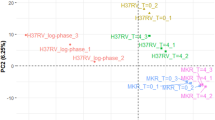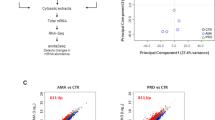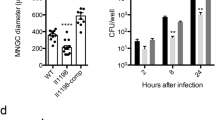Abstract
The mammalian cell entry (Mce)1 protein complex has an important role during the initial phase of a Mycobacterium tuberculosis (M. tuberculosis) infection. Murine macrophages were infected with M. tuberculosis H37Rv or Δ-mce1 H37Rv, and total RNA was isolated from the host cells at 15, 30 and 60 min, and 4 and 10 h post-infection. With the aim of studying the role for the Mce1 protein complex on host gene expression, the RNA was hybridized onto 44 K whole-genome microarrays. Selected genes were verified by reverse-transcriptase quantitative PCR (RT-QPCR). ‘Transport’ was the most overrepresented biological process during the first hour post H37Rv infection. Five genes (Abca1 (21.0-fold), Slc16a10 (3.1-fold), Slc6a12 (17.9-fold), Slc6a8 (2.3-fold) and Nr1h3, (5.5-fold)) involved in substrate trafficking were verified by RT-QPCR to be upregulated by >2-fold 1 h post H37Rv infection. By 1 h post Δ-mce1 H37Rv infection, only Abca1 and Slc6a12 were upregulated by >2-fold. A number of other genes, which may be directly involved in substrate trafficking or share the same transcription, were found to have expression profiles similar to the genes involved in substrate trafficking. The Mce1 protein complex has a significant role in the transcriptional activation of genes involved in substrate trafficking during the initial phase of an M. tuberculosis infection.
This is a preview of subscription content, access via your institution
Access options
Subscribe to this journal
Receive 6 digital issues and online access to articles
$119.00 per year
only $19.83 per issue
Buy this article
- Purchase on Springer Link
- Instant access to full article PDF
Prices may be subject to local taxes which are calculated during checkout


Similar content being viewed by others
Accession codes
References
Arruda S, Bomfim G, Knights R, Huima-Byron T, Riley LW . Cloning of an M. tuberculosis DNA fragment associated with entry and survival inside cells. Science 1993; 261: 1454–1457.
Cole ST, Brosch R, Parkhill J, Garnier T, Churcher C, Harris D et al. Deciphering the biology of Mycobacterium tuberculosis from the complete genome sequence. Nature 1998; 393: 537–544.
Chitale S, Ehrt S, Kawamura I, Fujimura T, Shimono N, Anand N et al. Recombinant Mycobacterium tuberculosis protein associated with mammalian cell entry. Cell Microbiol 2001; 3: 247–254.
Haile Y, Caugant DA, Bjune G, Wiker HG . Mycobacterium tuberculosis mammalian cell entry operon ( mce ) homologs in Mycobacterium other than tuberculosis (MOTT). FEMS Immunol Med Microbiol 2002; 33: 125–132.
Gioffré A, Infante E, Aguilar D, Santangelo MD, la P, Klepp L et al. Mutation in mce operons attenuates Mycobacterium tuberculosis virulence. Microbes Infect 2005; 7: 325–334.
Shimono N, Morici L, Casali N, Cantrell S, Sidders B, Ehrt S et al. Hypervirulent mutant of Mycobacterium tuberculosis resulting from disruption of the mce1 operon. Proc Natl Acad Sci USA. 2003; 100: 15918–15923.
Beste DJV, Espasa M, Bonde B, Kierzek AM, Stewart GR, McFadden J . The genetic requirements for fast and slow growth in mycobacteria. PLoS One 2009; 4: e5349.
Casali N, Riley LW . A phylogenomic analysis of the Actinomycetales mce operons. BMC Genomics 2007; 8: 60.
Dunphy KY, Senaratne RH, Masuzawa M, Kendall LV, Riley LW . Attenuation of Mycobacterium tuberculosis functionally disrupted in a fatty acyl-coenzyme A synthetase gene fadD5. J Infect Dis 2010; 201: 1232–1239.
Stavrum R, Stavrum A-K, Valvatne H, Riley LW, Ulvestad E, Jonassen I et al. Modulation of transcriptional and inflammatory responses in murine macrophages by the Mycobacterium tuberculosis mammalian cell entry (Mce) 1 Complex. PLoS ONE 2011; 6: e26295.
Fessele S, Maier H, Zischek C, Nelson PJ, Werner T . Regulatory context is a crucial part of gene function. Trends Genet 2002; 18: 60–63.
Hediger MA, Romero MF, Peng J-B, Rolfs A, Takanaga H, Bruford EA . The ABCs of solute carriers: physiological, pathological and therapeutic implications of human membrane transport proteinsIntroduction. Pflügers Archiv Eur J Physiol 2004; 447: 465–468.
Knight BL . ATP-binding cassette transporter A1: regulation of cholesterol efflux. Biochem Soc Trans 2004; 32 (Part 1): 124–127.
Subtil A, Gaidarov I, Kobylarz K, Lampson MA, Keen JH, McGraw TE . Acute cholesterol depletion inhibits clathrin-coated pit budding. Proc Natl Acad Sci USA 1999; 96: 6775.
Casali N, Konieczny M, Schmidt MA, Riley LW . Invasion activity of a Mycobacterium tuberculosis peptide presented by the Escherichia coli AIDA Autotransporter. Infect Immun 2002; 70: 6846–6852.
Casali N, White AM, Riley LW . Regulation of the Mycobacterium tuberculosis mce1 operon. J Bacteriol 2006; 188: 441–449.
Korf H, Vander Beken S, Romano M, Steffensen KR, Stijlemans B, Gustafsson J-A et al. Liver X receptors contribute to the protective immune response against Mycobacterium tuberculosis in mice. J Clin Invest 2009; 119: 1626–1637.
Brzostek A, Pawelczyk J, Rumijowska-Galewicz A, Dziadek B, Dziadek J . Mycobacterium tuberculosis is able to accumulate and utilize cholesterol. J Bacteriol 2009; 191: 6584.
Chawla A, Boisvert WA, Lee C-H, Laffitte BA, Barak Y, Joseph SB et al. A PPARγ-LXR-ABCA1 Pathway in Macrophages Is Involved in Cholesterol Efflux and Atherogenesis. Molecular Cell 2001; 7: 161–171.
Joseph SB, Bradley MN, Castrillo A, Bruhn KW, Mak P a, Pei L et al. LXR-dependent gene expression is important for macrophage survival and the innate immune response. Cell 2004; 119: 299–309.
Belisle JT, Vissa VD, Sievert T, Takayama K, Brennan PJ, Besra GS . Role of the major antigen of Mycobacterium tuberculosis in cell wall biogenesis. Science 1997; 276: 1420–1422.
Alcaïs A, Sanchez FO, Thuc NV, Lap VD, Oberti J, Lagrange PH et al. Granulomatous reaction to intradermal injection of lepromin (Mitsuda reaction) is linked to the human NRAMP1 gene in Vietnamese leprosy sibships. J Infect Dis 2000; 181: 302–308.
Cobat A, Gallant CJ, Simkin L, Black GF, Stanley K, Hughes J et al. Two loci control tuberculin skin test reactivity in an area hyperendemic for tuberculosis. J Exp Med 2009; 206: 2583–2591.
Lee SH, Oh T, Jeon B-Y, Kwak E-Y, Shim W-S, Cho S-N et al. Tissue-specific changes in mRNA expression of Abc and Slc transporters in murine pulmonary tuberculosis. Xenobiotica 2009; 39: 738–748.
Dysvik B, Jonassen I . J-Express: exploring gene expression data using Java. Bioinformatics 2001; 17: 369–370.
Breitling R, Armengaud P, Amtmann A, Herzyk P . Rank products: a simple, yet powerful, new method to detect differentially regulated genes in replicated microarray experiments. FEBS Lett 2004; 573: 83–92.
Thomas PD, Campbell MJ, Kejariwal A, Mi H, Karlak B, Daverman R et al. PANTHER: a library of protein families and subfamilies indexed by function. Genome Res 2003; 13: 2129–2141.
Acknowledgements
We thank Karl-Henning Kalland and Kari Rostad for constructive advice, Kristi Øvreås and Kjell Petersen for technical assistance, Haukeland University Hospital for P3-laboratory facilities, the Norwegian Microarray Consortium, Bergen, for microarray facilities, and the FUGE bioinformatics platform for valuable bioinformatics support. This study was funded by the Research Council of Norway project no. 179342 and 196362, and the Western Norway Regional Health Authority project no. 911207 and 911265.
Author information
Authors and Affiliations
Corresponding author
Rights and permissions
About this article
Cite this article
Stavrum, R., Valvatne, H., Stavrum, AK. et al. Mycobacterium tuberculosis Mce1 protein complex initiates rapid induction of transcription of genes involved in substrate trafficking. Genes Immun 13, 496–502 (2012). https://doi.org/10.1038/gene.2012.24
Received:
Accepted:
Published:
Issue Date:
DOI: https://doi.org/10.1038/gene.2012.24



